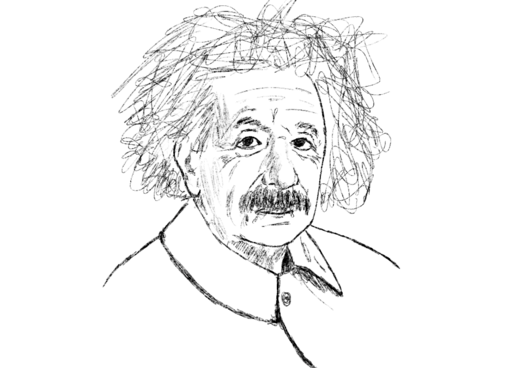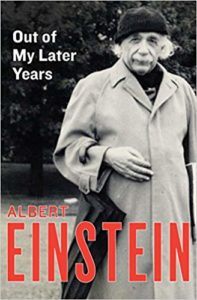
Drawing by Nathaniel St. Clair
“If I had known that the Germans would not succeed in constructing an atom bomb, I never would have moved a finger,” wrote Albert Einstein in his 1950 book Out of My Later Years.
He was speaking about a letter from his vacation home on Nassau Point on Long Island that warned President Franklin D. Roosevelt of a breakthrough in Nazi Germany in nuclear fission which could “lead to the construction of bombs, and it is conceivable…extremely powerful bombs of a new type.” Atom bombs.
That letter from Einstein triggered the Manhattan Project crash program of the United States to build atomic weaponry—to construct atom bombs before Nazi Germany did. And it led to a widening of nuclear technology and what has been called the “Atomic Age.”
On this August 2nd, on the anniversary of the August 2, 1939 date on that letter, the current owners of Rothman’s Department Store in Southold on Long Island unveiled Einstein Square in front of the store, centered around a bust of Einstein. The scientist was good friends in the 1930s with David Rothman, the store’s owner when he rented a house on nearby Nassau Point.
I first saw the Einstein letter as a youngster in a display case in the FDR Presidential Library and Museum in Hyde Park. I had the feeling then of its great importance. Now I think it might be the most important letter ever. I reprinted part of the letter as a facsimile in my 1980 book, Cover Up: What You Are Not Supposed to Know About Nuclear Power, and discuss it in other writings and in TV programs I’ve hosted.
(According to a December 20, 1986 Washington Post article, now online, the letter “was sold to  publisher Malcom Forbes today at Christies for $220,000. The price was a record for a 20th century letter.”)
publisher Malcom Forbes today at Christies for $220,000. The price was a record for a 20th century letter.”)
In fact, Einstein didn’t write the letter—although he signed and reviewed it. It was written by physicist Leo Szilard. Fission—the splitting of atoms—had just been done in December 1938 in Germany. Szilard realized the process could be used to create an atomic chain reaction. He made visits to Einstein at his vacation home on Nassau Point with fellow physicists Eugene Wigner and Edward Teller.
The one-and-a-half page letter—with Albert Einstein, Old Grove Road, Nassau Point, Peconic, Long Island typed on top—cited the fission experiment in Germany and said “it may become possible to set up a nuclear chain reaction in a large mass of uranium by which vast amounts of power and large quantities of new radium-like elements would be generated.”
“A single bomb of this type,” it goes on, “carried by boat and exploded in a port, might very well destroy the whole port together with some of the surrounding territory. However, such bombs might very well prove to be too heavy for transportation by air. The United States has only very poor ores of uranium in moderate quantities. There is some good ore in Canada and the former Czechoslovakia, while the most important source of uranium is Belgian Congo.”
The letter continued, “I understand Germany has actually stopped the sale of uranium from the Czechoslovakian mines which she has taken over”—an indication that Nazi Germany could be pursuing atomic weaponry. It urged “government action” by the United States.
After receiving the letter, President Roosevelt acted and the Manhattan Project was formed with major secret laboratories at several locations in the United States, notably Los Alamos, New Mexico and Oak Ridge, Tennessee.
By the time the Manhattan Project produced atom bombs, Germany was defeated. Two of the bombs were then dropped on its ally Japan. Szilard was opposed to this maintaining that dropping atom bombs on Japan “could not be justified, at least not until the terms which will be imposed after the war on Japan were made public in detail and Japan were given an opportunity to surrender.” Szilard put together a petition signed by hundreds of Manhattan Project scientists asking that atom bombs not be used on Japan. He and other scientists had earlier collaborated on a 1945 report in which Szilard and some of them called for the U.S. to conduct an atom bomb demonstration to make it clear to Japan the consequences of refusing to surrender. Other scientists involved in the report disagreed. As Manhattan Project physicist Arthur Compton wrote: “We see no acceptable alternative to direct military use.”
Einstein regretted signing the August 2nd letter and was critical, too, of how atom bombs had led to civilian atomic energy. He also wrote in Out of My Later Years: “Since I do not foresee that atomic energy is to be a great boon for a long time, I have to say that for the present time it is a menace.”